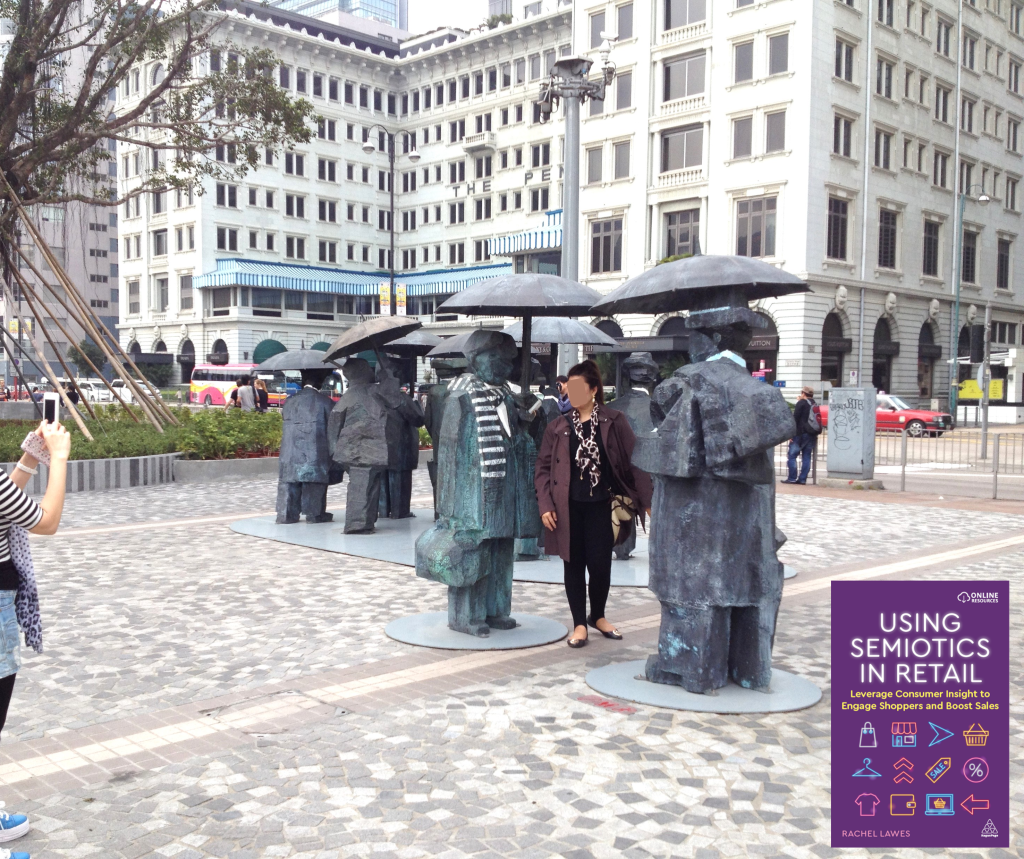Advertisers, retailers and retail marketers! Make room for people to insert their bodies into your display.

Advertisers, retailers and retail marketers! Make room for people to insert their bodies into your display. Don’t cram every available space with your own messages and products. People will take photos of themselves with your display and you’ll have created an opportunity for them to appreciate themselves as works of art.
I took this photo in Hong Kong in 2014. It’s an outdoor sculpture by artist Jung Ming (2003), its name is ‘Gentlemen’. Actually, it is properly called an ‘environmental sculpture’ because it pays attention to the setting, the weather, the people one encounters in a certain type of place. Its most important aspect is the negative space – the inviting empty space into which people insert themselves. The businessmen with their umbrellas aren’t huddled together in a crowd that can only be observed from a distance. They are intentionally arranged so that there are spaces for people to walk through and between them. I was in HK researching advertising on public transport for JCDecaux and they sensibly allowed me lots of time to explore and observe the environment rather than creating an over-full itinerary where I had to rush from one location to another. I spent quite a bit of time in this area, where there were several sculptures by Jung Ming, watching people interact with them. People found them irresistible. The sculptures were never unattended.
You can and should create negative space in store and in every type of retail setting, including airports, metro stations and outdoor markets. Here’s an extract from my book “Using Semiotics in Retail”.
“Use negative space. Negative space is any unfilled space that surrounds a product or fixture, in a two-dimensional image or in a physical store. Negative space will occur naturally unless you make a point of eliminating it. My advice is to keep it, but use it intentionally. Intentional use of negative space is what you see when a circular fixture on a shop floor can be approached on all sides. The space and the movement of shoppers through space is an intentional part of the fixture’s design. Unintentional negative space is what surrounds the last remaining package of toilet paper on an otherwise empty supermarket shelf.”
The book this advice appears in won an award: Best book on Sales & Marketing, Business Book Awards 2023. “Using Semiotics in Retail: Leverage Consumer Insight to Engage Shoppers and Boost Sales” is available worldwide.
#advertising #retail #retailmarketing #art #sculpture #environment #interactivity #photography #design #semiotics #mrx #research #observation #fieldwork #consumerinsights #shopperinsights #shoppermarketing
© 2021 Lawes Consulting. All rights reserved.
Website By the Scruff

0 Comments